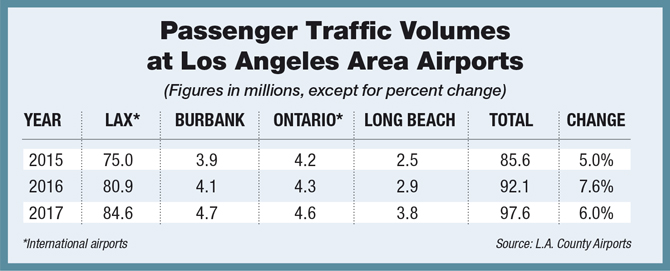The four commercial airports serving Los Angeles County handled 97.6 million passengers on a combined basis in 2017, a 6 percent year-over-year increase compared with a 2.9 percent rate nationally, according to the U.S. Bureau of Transportation Statistics.
Los Angeles International Airport remained the biggest contributor to the regional count by far, thanks to 4.5 percent increase from a year earlier.
Long Beach Airport saw the largest percentage increase in passenger traffic of 33 percent on its smallest-of-the-field base for 2017.
Volume at Hollywood Burbank Airport rose 14.4 percent, while Ontario International Airport recorded a 7 percent increase.
The airports together will need to grow by only 2.5 percent this year – well below rates of recent years – to put them at the 100 million mark. That would put them close to Hartsfield-Jackson Atlanta International Airport, the world’s busiest, with its 104 million passenger count last year.
L.A.’s regional total would still fall well short of 132 million passengers last year at the three airports serving the New York market: John F. Kennedy International Airport, Newark Liberty International Airport and LaGuardia Airport.
Local growth
A continued surge in international flights at LAX and double-digit growth in passenger tallies at Hollywood Burbank Airport and Long Beach Airport drove much of the overall growth last year, officials with the airports said. Ontario International Airport, now operating independently after separating from Los Angeles World Airports, which runs LAX, posted its biggest gain in passenger traffic in more than a decade.
“These numbers show Southern California as a busy and prosperous place and a nice destination to come to for tourists, business or anything else,” said Michael Boyd, president of Boyd Group International, a Denver aviation consulting firm.
Passenger volume at L.A. County’s airports in 2017 grew more slowly than the 7.6 percent rate the year prior. But Boyd characterized that slowdown as a return to more sustainable growth.
“What we saw in 2016, with that growth rate topping 7 percent, was a reflection of a surge in new international markets opening up for the first time, especially in China,” he said. “Since then, there just haven’t been as many new markets to tap as we saw a couple years ago. So it’s only natural that the growth rate slows. But the Los Angeles market is still very strong.”
LAX
The slowdown in growth was most pronounced at LAX, the “800-pound gorilla” in the commercial aviation arena for the region. Last year, nearly 84.6 million passengers went through the airport, up 4.5 percent from 2016, but well off the 7.9 percent growth between 2015 and 2016.
Los Angeles World Airports spokesman Charles Pannunzio said in an email that an unusually high number of international routes and carriers came on line at LAX during 2016.
LAX is expected to continue adding international flights at a moderate pace over the next couple years. But, Boyd said, the passenger growth rate will likely pick up again after the expected completion of the $1.6 billion north midfield satellite concourse now under construction next to the Tom Bradley International Terminal; when that opens in late 2019 or early 2020, it will add 12 gates for international flights.
Long Beach
Long Beach Airport experienced the biggest percentage growth in passenger traffic.
There, nearly 3.8 million passengers went through the terminals, up 33 percent from 2016.
Airport spokeswoman Stephanie Montuya-Morisky said the increase stems from a 2015 decision by the Long Beach City Council to add nine daily flights to the 41 existing ones. Under a formula worked out as part of a noise abatement settlement with residents and the Federal Aviation Administration, airport officials can raise the number of flights if the cumulative decibel count is substantially below the allowable limit.
Hollywood Burbank
Another airport with double-digit percentage growth in passengers last year was Hollywood Burbank, as more than 4.7 million people went through the terminals, up 14.4 percent from 2016.
Spokeswoman Rachael Warecki said that airport officials believe a general uptick in economic conditions, the addition of flights, and the airlines’ use of larger-capacity aircraft all contributed to this increase.
The airport does face constraints in adding flights, so that double-digit growth isn’t likely to continue.
The airlines operate under a voluntary nighttime curfew that some residents are trying to make mandatory and the number of gates appears set at 14, even as voters have approved plans for a new terminal to replace the two aging ones there.
Ontario International
Ontario International appears poised to lead in percentage growth in passengers in the years ahead. Last year, the first in which the airport was no longer run by Los Angeles World Airports, the Ontario International Airport Authority scored its first transoceanic success with the recent agreement for China Airlines to launch daily flight service this spring to Taipei, Taiwan.
“Reaching this agreement just months after assuming local control over the airport shows just how much pent-up demand there is for service to Ontario,” said Alan Wapner, chairman of the airport authority.
That major growth, though, still lies in the future.

